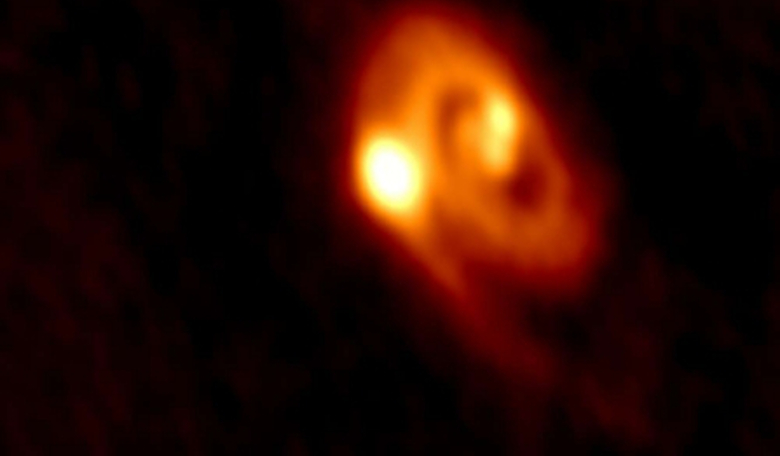Scientists using the Atacama Large Millimeter/submillimeter Array (ALMA) have detected a rare triple-star system in the early stages formation, still surrounded by a disk with a spiral structure - helping to cement the idea that young binary and multiple star systems are formed through disk fragmentation.
Almost half of all sun-like stars have at least one companion star making binary and multiple star systems very common. But exactly how they are formed is still something of a mystery, although fragmentation of the gaseous disk in which they form is considered a main driving force.
Stars initially form from a cloud of interstellar gas that is collapsing under its own gravity and, in a process that can be compared to a figure skater doing a spin who has pulled in their arms to gather speed, the spin from the cloud causes a disk to form as the material spins faster and falls toward the star. If the disk of gas is large enough, spiral arms form and the disk can fragment to another star.
The system observed by an international team of astronomers and headed by John J. Tobin, professor of astrophysics at the University of Oklahoma, is located in the Perseus molecular cloud at a distance of around 230 parsecs from Earth. Known as L1448 IRS3B, it spans a region about five times the size of our own solar system and is estimated to be less than 150,000 years in age, hence it is expected to be in an early phase of star formation.
“What is important is that we discovered that companion stars can form in disk material surrounding a dominant star,” said Tobin. “We had observed this system in the past with ALMA’s predecessors, but this is the first time we have been able to clearly analyse the disk and the newborn stars within it. ALMA revealed the spiral arms and disk that led to the formation of the tri-star system. Triple systems like this one are rare, and this is the only one with a configuration like this, but we are actively searching for more.”
In a paper released to Nature today, the team state that, “our results demonstrate that protostellar disks can experience gravitational instability at young ages, leading to the formation of hierarchical multiple systems…this discovery, together with the recent work supporting turbulent fragmentation at larger scales (1,000s of astronomical units), provide direct observational support for the two dominant theoretical models for binary/multiple star formation.”
The two main theories that Tobin refers to are either small scale fragmentation of a massive protostellar disk due to gravitational instability or larger scale fragmentation of turbulent gas cores and filaments.
More evidence from more systems will be needed to help narrow down which of the two theories is more likely, or indeed if both are viable candidates to explain multiple star systems and it is with facilities like ALMA that will be key in solving this conundrum once and for all.











